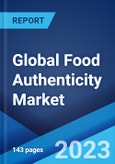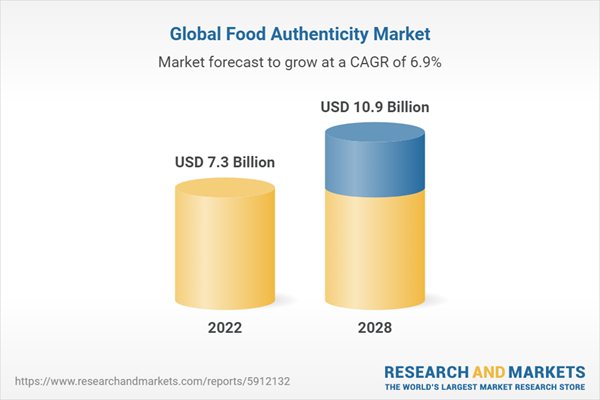The global food authenticity market size reached US$ 7.3 Billion in 2022. Looking forward, the market is expected to reach US$ 10.9 Billion by 2028, exhibiting a growth rate (CAGR) of 6.91% during 2022-2028.
Food authenticity refers to testing food and beverages in laboratories to examine their quality and ensuring authenticity. It involves running validation, quality, purity level and usage preference checks for ensuring the legitimacy of label claims on the product. Some commonly used techniques include deoxyribonucleic acid (DNA) testing, chromatography, microscopy, polymerase chain reaction (PCR), immunoassay and food allergen analysis. These tests aid in detecting deliberate substitution, addition, tampering and misrepresentation of food, ingredients and packaging or false and misleading statements regarding the product for economic gain. Food authentication tests are commonly used for confectionaries, packaged foods, meat-based and dairy-based products, cereals, grains, pulses, juices, edible oils, alcohols and processed foods.
Food authenticity refers to testing food and beverages in laboratories to examine their quality and ensuring authenticity. It involves running validation, quality, purity level and usage preference checks for ensuring the legitimacy of label claims on the product. Some commonly used techniques include deoxyribonucleic acid (DNA) testing, chromatography, microscopy, polymerase chain reaction (PCR), immunoassay and food allergen analysis. These tests aid in detecting deliberate substitution, addition, tampering and misrepresentation of food, ingredients and packaging or false and misleading statements regarding the product for economic gain. Food authentication tests are commonly used for confectionaries, packaged foods, meat-based and dairy-based products, cereals, grains, pulses, juices, edible oils, alcohols and processed foods.
Food Authenticity Market Trends
The rising incidence of frauds, false labeling, certification and adulterations in food products is one of the key factors driving the growth of the market. Moreover, the increasing awareness among consumers regarding food quality is providing a thrust to the market growth. PCR-based tests are widely used to check food authenticity in meat-based food products. It is a molecular technique that uses DNA to analyze meat and other food products, providing precise results on testing. The test amplifies fragments of DNA extracted from the product samples to accurately identify the DNA of each species in the product. This enables cross-checking of the authenticity of the product and confirmation of the claims. Additionally, various technological advancements, such as the development of remote testing kits and analytical testing software, are acting as other growth-inducing factors. These solutions assist in maintaining transparent supply chains through efficient data sharing and early warning systems. Other factors, including significant growth in the food and beverage industry across the globe, along with the implementation of favorable government policies, are anticipated to drive the market toward growth.Key Market Segmentation
This research provides an analysis of the key trends in each sub-segment of the global food authenticity market report, along with forecasts at the global, regional and country level from 2023-2028. The report has categorized the market based on target testing, technology and food tested.Breakup by Target Testing:
- Meat Speciation
- Country of Origin and Aging
- Adulteration Test
- False Labelling
Breakup by Technology:
- Polymerase Chain Reaction Based
- Liquid Chromatography-Mass Spectrometry
- Isotope Method
- Immunoassay Based/ELISA
Breakup by Food Tested:
- Meat and Meat Product
- Dairy and Dairy Product
- Cereal, Grain, and Pulse
- Processed Food
Breakup by Region:
- North America
- United States
- Canada
- Asia-Pacific
- China
- Japan
- India
- South Korea
- Australia
- Indonesia
- Europe
- Germany
- France
- United Kingdom
- Italy
- Spain
- Russia
- Latin America
- Brazil
- Mexico
- Middle East and Africa
Competitive Landscape
The competitive landscape of the industry has also been examined along with the profiles of the key players being ALS Limited, EMSL Analytical Inc., Eurofins Scientific Inc., Intertek Group plc, LGC Limited, Mérieux NutriSciences, Microbac Laboratories Inc., Romer Labs Division Holding GmbH (Koninklijke DSM N.V.) and SGS SA.Key Questions Answered in This Report:
- How has the global food authenticity market performed so far and how will it perform in the coming years?
- What has been the impact of COVID-19 on the global food authenticity market?
- What are the key regional markets?
- What is the breakup of the market based on the target testing?
- What is the breakup of the market based on the technology?
- What is the breakup of the market based on the food tested?
- What are the various stages in the value chain of the industry?
- What are the key driving factors and challenges in the industry?
- What is the structure of the global food authenticity market and who are the key players?
- What is the degree of competition in the industry?
Table of Contents
1 Preface3 Executive Summary11 Value Chain Analysis13 Price Analysis
2 Scope and Methodology
4 Introduction
5 Global Food Authenticity Market
6 Market Breakup by Target Testing
7 Market Breakup by Technology
8 Market Breakup by Food Tested
9 Market Breakup by Region
10 SWOT Analysis
12 Porters Five Forces Analysis
14 Competitive Landscape
Companies Mentioned
- ALS Limited
- EMSL Analytical Inc.
- Eurofins Scientific Inc.
- Intertek Group plc
- LGC Limited
- Mérieux NutriSciences
- Microbac Laboratories Inc.
- Romer Labs Division Holding GmbH (Koninklijke DSM N.V.)
- SGS SA
Methodology

LOADING...
Table Information
| Report Attribute | Details |
|---|---|
| No. of Pages | 143 |
| Published | November 2023 |
| Forecast Period | 2022 - 2028 |
| Estimated Market Value ( USD | $ 7.3 Billion |
| Forecasted Market Value ( USD | $ 10.9 Billion |
| Compound Annual Growth Rate | 6.9% |
| Regions Covered | Global |
| No. of Companies Mentioned | 9 |









